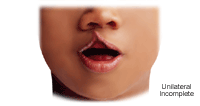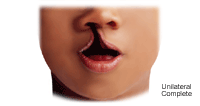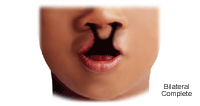Cleft Lip/Cleft Palate
What are cleft lip and cleft palate?
Cleft lip and cleft palate are birth abnormalities of the mouth and lip. In the United States, nearly 6,800 babies are born with oral-facial clefts annually. These abnormalities occur less frequently among African-Americans. Cleft lip and cleft palate occur early in pregnancy when the sides of the lip and the roof of the mouth do not fuse together as they should. A child can have cleft lip, cleft palate, or both. Cleft lip and cleft palate together are more common in boys. It is also important to know that most babies born with a cleft are otherwise healthy with no other birth abnormalities.
-
Cleft palate: Cleft palate occurs when the roof of the mouth does not completely close, leaving an opening that can extend into the nasal cavity. The cleft may involve either side of the palate. It can extend from the front of the mouth (hard palate) to the throat (soft palate). Often the cleft will also include the lip. Cleft palate is not as noticeable as cleft lip because it is inside the mouth. It may be the only abnormality in the child, or it may be associated with cleft lip or other syndromes. In many cases, other family members have also had a cleft palate at birth.
-
Cleft lip: Cleft lip is an abnormality in which the lip does not completely form during fetal development. The degree of the cleft lip can vary greatly, from mild (notching of the lip) to severe (large opening from the lip up through the nose). As a parent, it may be stressful to adjust to the obvious abnormality of the face, as it can be very noticeable.There are different names given to the cleft lip according to its location and how much of the lip is involved. A cleft on one side of the lip that does not extend into the nose is called unilateral incomplete. A cleft on one side of the lip that extends into the nose is called unilateral complete. A cleft that involves both sides of the lip and extends into and involves the nose is called bilateral complete.



Cleft lip and cleft palate may occur together in an infant, or separately. The degree of the abnormality of both cleft lip and cleft palate can vary greatly. The most common early problem associated with these abnormalities is feeding your baby.
What causes cleft lip and cleft palate?
The exact cause of cleft lip and cleft palate is not completely understood. Cleft lip and/or cleft palate are caused by multiple genes inherited from both parents, as well as environmental factors that scientists do not yet fully understand. When a combination of genes and environmental factors cause a condition, the inheritance is called "multifactorial" (many factors contribute to the cause). Because genes are involved, the chance for a cleft lip and/or cleft palate to happen again in a family is increased, depending on how many people in the family have a cleft lip and/or cleft palate. If parents without clefts have a baby with a cleft, the chance for them to have another baby with a cleft ranges from 3 to 5 percent. If a parent has a cleft, but no children have a cleft, the chance to have a baby with a cleft is 5 percent. If a parent and a child have a cleft, the chance is even greater for a future child to be born with a cleft. Genetic consultation is suggested.
What are the symptoms of cleft lip and cleft palate?
The symptoms of these abnormalities are visible during the first examination by your infant's doctor. Although the degree of the abnormality can vary, on inspection of the mouth and lips, the abnormality can be noted, as there is an incomplete closure of either the lip, roof of the mouth, or both.
What are the complications associated with cleft lip and cleft palate?
Beyond the cosmetic abnormality, there are other possible complications that may be associated with cleft lip and cleft palate, including the following:
-
Feeding difficulties: Feeding difficulties occur more with cleft palate abnormalities. The infant may be unable to suck properly because the roof of the mouth is not formed completely.
-
Ear infections and hearing loss: Ear infections are often due to a dysfunction of the tube that connects the middle ear and the throat. Recurrent infections can then lead to hearing loss.
-
Speech and language delay: Due to the opening of the roof of the mouth and the lip, muscle function may be decreased, which can lead to a delay in speech or abnormal speech. Referral to a speech therapist should be discussed with your child's doctor.
-
Dental problems: As a result of the abnormalities, teeth may not erupt normally and orthodontic treatment is usually required.
Feeding my baby with cleft palate
The most immediate concern for a baby with cleft palate is good nutrition. Sucking for children with a cleft palate is difficult because of the poorly formed roof of the mouth. Children with just a cleft lip (without a cleft palate) do not routinely have feeding difficulties. The following are suggestions to help aid in the feeding of your infant:
-
Breastfeeding is allowed. It will take extra time and patience. Be open for alternatives if this is not providing adequate nutrition for your infant. You may still pump your breast and feed your infant breast milk through other techniques.
-
Hold your infant in an upright position to help keep the food from coming out of the nose.
-
Other feeding devices may be utilized. Consult with your child's doctor for more information.
-
Small, frequent feedings are recommended. This can be a frustrating and slow process; however, your infant will receive more calories, and therefore, gain weight.
-
There are many types of bottles and nipples on the market that can assist with feeding an infant with cleft palate. Consult with your child's doctor regarding which type is most appropriate for your child. The following are a few examples:
-
NUK nipple: This nipple can be placed on regular bottles or on bottles with disposable bags. The hole can be made larger by making a criss-cross cut in the middle.
-
Mead Johnson Nurser®: This is a soft, plastic bottle that is easy to squeeze and has a large crosscut nipple. You may use any nipple that the infant prefers with this system.
-
Haberman Feeder®: This is a specially designed bottle system with a valve to help control the air the baby drinks and to prevent milk from going back into the bottle.
-
Syringes: These may be used in hospitals following cleft surgery and may also be used at home. Typically, a soft, rubber tube is attached on the end of the syringe, which is then placed in the infant's mouth.
In some cases, supplements may be added to breast milk or formula to help your infant meet his or her calorie needs. Consult your child's doctor regarding other home devices (i.e., small paper cups) for feeding your child with a cleft palate.
The team approach for managing and correcting cleft abnormalities
There may be many people involved in management of a cleft abnormality for your child, because the skills of many different areas are needed to help with the problems that can occur with cleft abnormalities. Visit our Cleft and Craniofacial team page to learn about the specialties who may be caring for your child.
Treatment for cleft lip and cleft palate
Treatment for these abnormalities includes surgery and a complete team approach to help with the multiple complications that can occur. Specific treatment will be determined by your child's doctor based on:
-
Your child's age, overall health, and medical history
-
Specific qualities of your child's abnormality
-
Your child's tolerance for specific medications, procedures, or therapies
-
Involvement of other body parts or systems
-
Your opinion or preference
For most infants with cleft lip alone, the abnormality can be repaired within the first several months of life (usually when the baby is 10 to 12 pounds). This will be decided by your child's surgeon. The goal of this surgery is to fix the separation of the lip. Sometimes, a second operation is needed.
Cleft palate repairs are usually done between the ages of 6 to 18 months. This is a more complicated surgery and is done when the baby is bigger and better able to tolerate the surgery. The exact timing of the surgery will be decided by your child's doctor. The goal of this surgery is to fix the roof of the mouth so that your child can eat and learn to talk normally. Sometimes, a second operation is needed.
-
Surgery: At your first visit with the plastic surgeon, he or she will discuss with you the details of the surgery, risks, complications, costs, recovery time, and outcome. At this time, your child's surgeon will answer any questions you may have.
-
After the surgery for cleft lip: Your child may be irritable following surgery. Your child's doctor may prescribe medications to help with this. Your child may also have to wear padded restraints on his or her elbows to prevent him or her from rubbing at the stitches and surgery site.
Stitches will either dissolve on their own or will be removed in approximately five to seven days. Specific instructions will be given to you regarding how to feed your child after the surgery. The scar will gradually fade, but it will never completely disappear.
During the surgery, and for a short time after surgery, your child will have an intravenous catheter (IV) to provide fluids until he or she is able to drink by mouth. For a day or two, your child will feel mild pain, which can be relieved with a nonaspirin pain medication. A prescription medication may also be given for use at home.
Your child's upper lip and nose will have stitches where the cleft lip was repaired. It is normal to have swelling, bruising, and blood around these stitches.
-
After the surgery for cleft palateThis surgery is usually more involved and can cause more discomfort and pain for the child than cleft lip surgery. Your child's doctor may order pain medicine to help with this. As a result of the pain and the location of the surgery, your child may not eat and drink as usual. An intravenous (IV) catheter will be used to help give your child fluids until he or she can drink adequately.
-
Your child will have stitches on the palate where the cleft was repaired. The stitches will dissolve after several days and they do not have to be taken out by the doctor. In some cases, packing will be placed on the palate. Do not take the packing out unless you are told to do so by your child's doctor.
-
There may be some bloody drainage coming from the nose and mouth that will lessen over the first day.
-
There will be some swelling at the surgery site, which will diminish substantially in a week.
-
For two to three days, your child will feel mild pain that can be relieved by a nonaspirin pain medication. A prescription medication may also be given for use at home.
-
Many infants show signs of nasal congestion after surgery. These signs may include nasal snorting, mouth breathing, and decreased appetite. Your child's doctor may prescribe medication to relieve the nasal congestion.
-
Your child will be on antibiotics to prevent infection while in the hospital. Your child's doctor may want you to continue this at home.
-
Your child may be in the hospital for one to three days, depending on your child's doctor's recommendation.
-
A small amount of water should be offered after every bottle or meal to cleanse the incision. You can continue to rinse this area gently with water several times a day, if necessary.
-
Diet after surgery: Your child's doctor may allow breastfeeding, bottle-feedings, or cup-feedings after surgery. Your child should be placed on a soft diet for seven to 10 days after surgery. For older infants and children, age-appropriate soft foods may include strained baby foods, popsicles, yogurt, mashed potatoes, and gelatin. Note: your child should not use a straw or pacifier, as both could damage the surgical repair.
-
Activity after surgery: Your child can walk or play calmly after surgery. He or she should not run or engage in rough play (i.e., wrestling, climbing) or play with "mouth toys" for one to two weeks after surgery. Your child's doctor will advise you when your child can safely return to regular play.
Follow-up with your child's surgeon and the cleft team is very important. This will be discussed with you. Your child's doctor will also be an important part of the child's overall health management after the surgery.